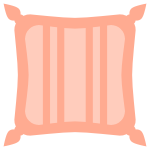Disclosure: As an Amazon Associate I earn from qualifying purchases.
You have probably already stepped into a completely empty room and immediately noticed how bad the room acoustics are.
The room echoes and feels somehow uncomfortable, almost like being in a cathedral. You would like to reduce the reverb immediately somehow .
Bad room acoustics cannot only occur in empty rooms. That is why it makes sense to design the rooms in your own four walls to be sound-optimized.
The problem of echoing rooms
Reverberant rooms with an echo effect have considerable disadvantages. It is particularly noticeable that speech intelligibility suffers in such rooms. You have to work very hard to follow a conversation.
The more people are in such a room, the more disturbing background noises arise and the poorer the speech intelligibility.
Due to the long reverberation time, other noises are also perceived louder.
A reverberant room is loud and exhausting on the ears.
But why is it like that?
Problem child reverberation
The problem child is called reverberation. This occurs when sound waves are reflected multiple times from different surfaces before they reach the human ear.
We covered this topic in more detail at the previous link. You can of course also find a lot of information on Wikipedia .
Fortunately, it is relatively easy to do something about the reverberation.
14 ideas to reduce the reverb
In general, one can say that open, soft and porous materials are better for surround sound than smooth, hard and closed surfaces.
So what really helps against too much reverberation in rooms?
In the following you will find 14 ideas to reduce the reverberation effectively and often relatively cheaply, and thus to improve the surround sound:

1. Set up upholstered furniture
Textile-related upholstered furniture such as armchairs, sofas, sofa beds, loungers or chaise longues are good sound absorbers and can reduce the reverberation time in the room. The more upholstered furniture, the better.
Instead of setting up seating furniture made of smooth leather or tubular steel furniture, you should use upholstered furniture in the interests of a better room sound.
Such furniture is cozy and makes the room appear warm and calm.

2. Lay out carpets
Hard surfaces such as smooth wooden floors can increase the reverberation time because noises bounce off them.
It is therefore better if such floors are at least partially covered with a carpet. In particular, fluffy and deep-pile carpets are preferable.
It is no coincidence that deep-pile carpets are also used in many hotel rooms, where things should naturally be as quiet as possible.
You can either lay carpeting in the whole room or cover the floor with individual carpets with thick and dense long pile, as this has a noise-absorbing effect.
There are so-called play rugs for children’s rooms, which can also contribute to a quieter environment.

3. Hang up acoustic pictures
Acoustic pictures are enjoying increasing popularity. At least that’s what you can assume when you see the ever-increasing range of such images.
Acoustic pictures can reduce annoying reverberation and noise in the room due to the integrated sound absorbers and they also look great. There are now such pictures with a variety of motifs and colors and of course in different sizes.
It is particularly effective to hang several such pictures in the room.
As an example, take a look at this great acoustic picture on Amazon * , which consists of a total of 5 parts and thus covers a fairly large area on the wall.
This acoustic image is not only effective, but also very decorative, don’t you think?

4. Set up bookshelves
A well-filled bookshelf can have a positive effect on the room acoustics, as books can also absorb some of the sound.
In addition, bookshelves naturally also contribute to the cosiness of a living room.
A friend of ours recently dismantled his large bookshelf in a fit of minimalism and gave away all of his books because he thought he didn’t want to read them again anyway.
When everything was gone, however, he was annoyed by the sudden echo in the living room and immediately looked for alternatives. So even if you don’t read your old books again, they can still serve a purpose in terms of surround sound.

5. Integrate sound absorbers
If you want to reduce the reverberation, you should definitely think about buying one or more sound absorbers .
These practical tools can be used in different forms in different places in the room. This allows you to individually and flexibly improve your room sound and also live it out in terms of room decoration.
Sound absorbers are available for walls, for the ceiling, as room dividers, as an acoustic image or as elements (cubes, pyramids, etc.) that can be set up freely in the room.
Very decorative sound absorbers for hanging on the wall are, for example, these here at Amazon * , which come in many different colors and different sizes.
These absorbers can be used flexibly and can also be easily combined with one another.

6. Hang up the curtains
Hard and reflective surfaces such as large glass windows cause reflections and reverberation.
It is therefore advisable to defuse such large glass surfaces acoustically with a soundproof curtain or curtains,
Dense and heavy curtains are particularly suitable here, such as this noise protection curtain on Amazon * .

7. Install ceiling rafts
Ceiling sails are also a great way to improve room acoustics and dampen reverb.
The fact that such ceiling sails hardly take up any space is particularly practical, as they are simply hung from the ceiling and do their job there.
This ceiling sail here at Amazon * is available in different sizes and colors and is simply attached to the ceiling with 4 steel cables at the desired suspension height.

8. Hang up the acoustic panels
Another popular way to reduce reverberation is to use acoustic panels made from pyramid or convoluted foam.
Such installations are often seen in studios, recording rooms or rehearsal rooms. But of course, pyramid foam is also effective in your own four walls.
You are very flexible with this set * of pyramid foam soundproofing panels, which consists of 24 panels with the dimensions 25 x 25 x 5 cm per panel.

9. Attach the tapestries
Tapestries have certainly gone out of style lately. But why actually?
A modern tapestry is a beautiful wall decoration and can also reduce the reverberation.

10. Lay out the pillow
Beautiful, large and fluffy pillows are not only cozy, they also have a noise-absorbing effect.
Whether sofa cushions, chair cushions, floor cushions or pillows for children – cushions can be used universally and you can actually never have enough of them.

11. Use fabric lampshades
For some, fabric lampshades are unnecessary dust catchers, while for others they can contribute to a better spatial sound.
Even if a lampshade alone certainly does not improve the room sound effectively – large lampshades made of fabric are more beneficial to the room sound than models made of glass or metal.

12. Set up indoor plants
Indoor plants not only look beautiful and improve the indoor climate, they can even help to improve the spatial sound.
In particular, large, leafy plants are preferable for this purpose, as they can absorb some of the sound. In this way you can reduce the annoying reverb in a very natural way.

13. Use fabric blinds
Large windows are always a problem when it comes to reverberation. You should therefore pay particular attention to the windows when it comes to reducing the reverberation.
While heavy and thick curtains are certainly more effective, they do not suit everyone. Fabric blinds can therefore be an alternative. The thicker the fabric, the better.

14. Set up room divider (paravent)
In large rooms in particular, room dividers are a popular stylistic device to separate individual areas of the room to a certain extent and thus provide a little more cosiness.
Such partitions can also make a contribution to less reverberation and thus better spatial sound.
There are even room dividers that have a sound absorber built into them. Such models are of course a little more effective than a privacy screen made of fleece canvas or bamboo.
Conclusion on reducing reverb
Not only furnishings and colors make up a room, but also the sound of the room. Here we have presented you with 14 ideas to reduce the reverb and thus achieve a better spatial sound.
As you have seen from these ideas, you can achieve a lot with normal furnishings. In addition, there are also special tools available that can be integrated naturally into the room.
Disclosure: Amazon and the Amazon logo are trademarks of Amazon.com, Inc, or its affiliates.



